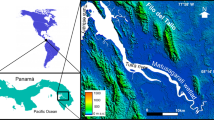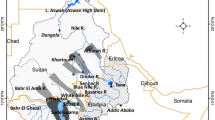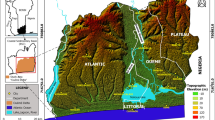Abstract
The Matusagaratí Wetland in the Panamanian Darien develops in fluvial environments associated with the Tuira River. The aim of this research is to determine the origin and dynamics of the water flows that sustain the Matusagaratí Wetland, studying the flows of surface water and groundwater, as well as the contributions derived from precipitation. Understanding the contributions and flows of water within the wetland acquires both hydrological and ecological significance, since flood events contribute to the accumulation of sediments and the transport and dispersal of seeds and fish larvae, playing an important role in the wetland ecosystems and vegetation variability. A monitoring network was designed as perpendicular transects to the Tuira River, encompassing wetland environments with different geomorphology and vegetation. Water flows were studied from the measurement of water levels and sampling in the Tuira River, in groundwater and in streams that drain from Filo del Tallo, also evaluating the influence of rainfall. In addition, the origin of the different sources of water that enter the wetland was assessed using stable water isotopes. The analysis show that different hydrodynamic behaviours exist along the river associated with the levee and floodplain sectors. The dynamics of the water in the Tuira River is determined by the runoff of excess rainfall, which is overlaid by a tidal regime resulting from the propagation of the tide from the estuary. This propagation causes variations in salinity along the river. The study of groundwater levels, water levels in the Tuira River and rainfall, supported by stable isotopes, allowed the identification of different environments, some of which depend mainly on the water contribution of the Tuira River, others on rainwater, and others where the contribution of water to the wetland is mixed. The results presented in this research contribute data to the generation of hydrological baseline for the understanding of the hydrological functioning of the wetland and the generation of management guidelines against the advance of anthropic activities that can modify it.










Similar content being viewed by others
Data availability
The datasets used and/or analyzed during the current study are available from the corresponding author on reasonable request.
References
Amoros C, Bornette G (2002) Connectivity and biocomplexity in waterbodies of riverine floodplains. Freshw Biol 47(4):761–776
Aratrakorn S, Thunhikorn S, Donald P (2006) Changes in bird communities following conversion of lowland forest to oil palm and rubber plantations in southern Thailand. Bird Conserv Int 16(1):71–82
Baúles A, Ibáñez A, Candanedo I (2020) Mapa de Vegetación Preliminar del Complejo de Humedales de Matusagaratí. Informe del Proyecto FID17-043, SENACYT. UTP
Beven K, Binley A (1992) The future of distributed models: model calibration and uncertainty prediction. Hydrol Process 6(3):279–298
Birkel C, Duvert C, Correa A, Munksgaard NC, Maher DT, Hutley LB (2020) Tracer-aided modeling in the low-relief, wet-dry tropics suggests water ages and DOC export are driven by seasonal wetlands and deep groundwater. Water Resour Res 56(4):e2019WR026175
Björk S (2010) The evolution of lakes and wetlands. In: Eiseltová M (ed) Restoration of lakes, streams, floodplains, and bogs in Europe: principles and case studies. Wetlands: ecology, conservation and management. Springer Science & Business Media, New York, pp 25–35
Bodmer R, Mayor P, Antunez M, Chota K, Fang T, Puertas P, Pittet M, Kirkland M, Walkey M, Rios C (2018) Major shifts in Amazon wildlife populations from recent intensification of floods and drought. Conserv Biol 32:333–344
Brinson MM, Malvárez AI (2002) Temperate freshwater wetlands: types, status, and threats. Environ Conserv 29(2):115–133
Carlson K, Curran L, Ratnasari D, Pittman A, Soares-Filho B, Asner G, Triggh S, Gaveaub D, Lawrence D, Rodrigues H (2012) Committed carbon emissions, deforestation, and community land conversion from oil palm plantation expansion in West Kalimantan, Indonesia. Proc Natl Acad Sci 109(19):7559–7564
Carol E, Kruse E, Mas Pla J (2009) Hydrochemical and isotopical evidence of ground water salinization processes on the coastal plain of Samborombón Bay. Argentina. J Hydrol 365(3–4):335–345
Carol E, Kruse E, Pousa J (2011) Influence of the geologic and geomorphologic characteristics and of crab burrows on the interrelation between surface water and groundwater in an estuarine coastal wetland. J Hydrol 403:234–241
Carol E, Dragani W, Kruse E, Pousa J (2012) Surface water and groundwater characteristics in the wetlands of the Ajó River (Argentina). Cont Shelf Res 49:25–33
Carol E, Mas Pla J, Kruse E (2013) Interaction between continental and estuarine waters in the wetlands of the northern coastal plain of Samborombón Bay, Argentina. Appl Geochem 34:152–163
Carol E, Alvarez MP, Borzi G (2016) Assessment of factors enabling halite formation in a marsh in a humid temperate climate (Ajó marsh, Argentina). Mar Pollut Bull 106:323–328
Carol E, Braga F, Donnici S, Kruse E, Tosi L (2017) The hydrologic landscape of the Ajó coastal plain, Argentina: an assessment of human-induced changes. Anthropocene 18:1–14
Carol E, Alvarez M, Candanero I, Saavedra S, Arcia M, Franco A (2020) Surface water–groundwater interactions in the Matusagaratí Wetland, Panama. Wetlands Ecol Manag 28(6):971–982
Chen B, Chen L, Huang B, Michishita R, Xu B (2018) Dynamic monitoring of the Poyang Lake wetland by integrating Landsat and MODIS observations. ISPRS J Photogramm Remote Sens 139:75–87
Clark I (2015) Groundwater geochemistry and isotopes. CRC Press, Boca Raton
CREHO (Centro Regional Ramsar para la Capacitación e Investigación en humedales en el hemisferio occidental) (2015) Diagnóstico socioambiental, Laguna de Matusagaratí, CREHO, CEASPA, ACD
Džubáková K, Piégay H, Riquier J, Trizna M (2015) Multi-scale assessment of overflow-driven lateral connectivity in floodplain and backwater channels using LiDAR imagery. Hydrol Process 29(10):2315–2330
Fritz KM, Schofield KA, Alexander LC, McManus MG, Golden HE, Lane CR, Pollard AI (2018) Physical and chemical connectivity of streams and riparian wetlands to downstream waters: a synthesis. JAWRA J Am Water Resources Assoc 54(2):323–345
Galliari J, Tanjal C, Alvarez M, Carol E (2020) Hydrochemical dynamics of a wetland and costal lagoon associated to the outer limit of the Rio de la Plata estuary. Cont Shelf Res. https://doi.org/10.1016/j.csr.2020.104109
Galliari J, Santucci L, Misseri L, Carol E, Alvarez M (2021) Processes controlling groundwater salinity in coastal wetlands of the southern edge of South America. Sci Total Environ. https://doi.org/10.1016/j.scitotenv.2020.141951
Gaveau D, Sheil D, Salim M, Arjasakusuma S, Ancrenaz M, Pacheco P, Meijaard E (2016) Rapid conversions and avoided deforestation: examining four decades of industrial plantation expansion in Borneo. Sci Rep 6(1):1–13
Gonfiantini. (1978) Standards for stable isotope measurements in natural compounds. Nature 271(5645):534
Gordon L, Finlayson C, Falkenmark M (2010) Managing water in agriculture for food production and other ecosystem services. Agric Water Manage 97:512–519
Hassan R, Scholes R, Ash N (2005) Ecosystems and human well-being: current state and trends. Island Press, Washington
Ibáñez A, Flores R (2020) Phyllanthus fluitans (Phyllanthaceae): a new record of an aquatic plant for the flora of Panama. Acta Botanica Mexicana 128:e1767. https://doi.org/10.21289/abm128.2021.1767
Kern Z, Harmon R, Forizs I (2016) Stable isotope signatures of seasonal precipitation on the Pacific coast of central Panama. Isot Environ Health Stud 52:128–140
Koerselman W, Bakker SA, Blom M (1990) Nitrogen, phosphorus and potassium budgets for two small fens surrounded by heavily fertilized pastures. J Ecol 78:428–442
Koreny J, Mitsch W, Bair E, Wu X (1999) Regional and local hydrology of a created riparian wetland system. Wetlands 19(1):182–193
Lane BA, Sandoval-Solis S, Porse EC (2014) Environmental flows in a human-dominated system: integrated water management strategies for the Rio Grande/Bravo Basin. River Res Appl 31:1053–1065
Lane B, Sandoval-Solis S, Stein E, Yarnell S, Pasternack GB, Dahlke H (2018) Beyond metrics? The role of hydrologic baseline archetypes in environmental water management. Environ Manage 62(4):678–693
Larocque M, Biron P, Buffin-Bélanger T, Needelman M, Cloutier C, McKenzie JM (2016) Role of the geomorphic setting in controlling groundwater–surface water exchanges in riverine wetlands: a case study from two southern Québec rivers (Canada). Can Water Resources J/revue Canadienne Des Ressources Hydriques 41(4):528–542
Li Y, Zhang Q, Lu J, Yao J, Tan Z (2019) Assessing surface water–groundwater interactions in a complex river-floodplain wetland-isolated lake system. River Res Appl 35(1):25–36
Lisenby P, Tooth S, Ralph T (2019) Product vs. process? The role of geomorphology in wetland characterization. Sci Total Environ 663:980–991
Lowry C, Walker J, Hunt R, Anderson M (2007) Identifying spatial variability of groundwater discharge in a wetland stream using a distributed temperature sensor. Water Resources Res 43:W10408. https://doi.org/10.1029/2007WR006145
Marthews TR, Dadson SJ, Clark DB, Blyth EM, Hayman G, Yamazaki D, Becher O, Martínez de la Torre A, Prigent C, Jiménez C (2021) Inundation prediction in tropical wetlands from JULES-CaMa-Flood global land surface simulations. Hydrol Earth Syst Sci Discuss 109:1–31. https://doi.org/10.5194/hess-2021-109
McLatchey G, Reddy K (1998) Regulation of organic matter decomposition and nutrient release in a wetland soil. Am Soc Agron Crop Sci Soc Am Soil Sci Soc Am 27(5):1268–1274
Mondal D, Pal S (2018) Monitoring dual-season hydrological dynamics of seasonally flooded wetlands in the lower reach of Mayurakshi River. Eastern India Geocarto Int 33(3):225–239
Neff B, Rosenberry D (2018) Groundwater connectivity of upland-embedded wetlands in the prairie pothole region. Wetlands 38(1):51–63
Ocampo-Peñuela N, Garcia-Ulloa J, Ghazoul J, Etter A (2018) Quantifying impacts of oil palm expansion on Colombia’s threatened biodiversity. Biol Cons 224:117–121
Ortiz O, Ibáñez A, Trujillo-Trujillo E, Croat T (2020) The emergent macrophyte Montrichardia linifera (Arruda) Schott (Alismatales: Araceae), a rekindled old friend from the Pacific Slope of lower Central America and western Colombia. Nord J Bot 38(9):1–10. https://doi.org/10.1111/njb.02832
Phillips JD (2013) Hydrological connectivity of abandoned channel water bodies on a coastal plain river. River Res Appl 29(2):149–160
Poff N, Zimmerman J (2010) Ecological responses to altered flow regimes: a literature review to inform the science and management of environmental flows. Freshw Biol 55:194–205
Poff NL, Richter BD, Arthington AH, Bunn SE, Naiman RJ, Kendy E, Acreman M, Apse C, Bledsoe BP, Freeman MC, Henriksen J, Jacobson RB, Kennen JG, Merritt DM, O’Keeffe JH, Olden JD, Rogers K, Tharme RE, Warner A (2010) The ecological limits of hydrologic alteration (ELOHA): a new framework for developing regional environmental flow standards. Freshw Biol 55:147–170
Robertson G, Paul E (2000) Decomposition and soil organic matter dynamics. In: Sala OE, Jackson RB, Mooney HA, Howarth RW (eds) HowarthMethods in ecosystem science. Springer, New York, pp 104–116
Royan A, Prudhomme C, Hannah D, Reynolds S, Noble D, Sadler J (2015) Climate-induced changes in river flow regimes will alter future bird distributions. Ecosphere 6:1–10
Salinas M, Casas J (2007) Riparian vegetation of two semi-arid Mediterranean rivers: basin-scale responses of woody and herbaceous plants to environmental gradients. Wetlands 27(4):831–845
Sanchez J, Ferguson T, Savage K (2017) Hydrological dynamics of two seasonal floodplain wetlands in the south Carolina piedmont. J Young Investig 33(4):91–98. https://doi.org/10.22186/jyi.33.4.90-98
Sánchez-Murillo R, Esquivel-Hernández G, Birkel C, Correa A, Welsh K, Durán-Quesada AM, Sánchez-Gutiérrez R, Poca M (2020) Tracing water sources and fluxes in a dynamic tropical environment: from observations to modeling. Front Earth Sci 8:571477. https://doi.org/10.3389/feart.2020.571477
Santucci L, Sanci R, Carol E, Villalba E, Panarello H (2019) Using H, O, Rn isotopes and hydrometric parameters to assess the surface water-groundwater interaction in coastal wetlands associated to the marginal forest of the Río de la Plata. Cont Shelf Res 186:104–110
Savilaakso S, Garcia C, Garcia-Ulloa J, Ghazoul J, Groom M, Guariguata MR, Yves LY, Nasi R, Petrokofsky G, Snaddon J, Zrust M (2014) Systematic review of effects on biodiversity from oil palm production. Environ Evidence 3(1):1–21
Stromberg J, Bagstad K, Leenhouts J, Lite S, Makings E (2005) Effects of stream flow intermittency on riparian vegetation of a semiarid region river (San Pedro River, Arizona). River Res Appl 21:925–938
Susilo A, Ridd P, Thomas S (2005) Comparison between tidally driven groundwater flow and flushing of animal burrows in tropical mangrove swamps. Wetlands Ecol Manage 13(4):377–388
Winter T (1999) Relation of streams, lakes, and wetlands to groundwater flow systems. Hydrogeol J 7(1):28–45. https://doi.org/10.1007/s100400050178
Winter T, Harvey J, Franke OL, Alley W (1998) Groundwater and surface water: a single resource. U.S Geological Survey Circular 1139. U.S: Geological Survey. Denver. https://pubs.usgs.gov/circ/1998/1139/report.pdf. Accessed 3 May 2021
Yu X, Hawley-Howard J, Pitt AL, Wang JJ, Baldwin RF, Chow AT (2015) Water quality of small seasonal wetlands in the Piedmont ecoregion, South Carolina, USA: effects of land use and hydrological connectivity. Water Res 73:98–108
Acknowledgements
The authors are much indebted to the Secretaría Nacional de Ciencia, Tecnología e Innovación (National Secretary of Science, Technology and Innovation) of Panama for financially supporting this study by means of their Grant FID 17-043, and to the Ministerio de Ambiente (Ministry of Environment of Panama) of Panama for supporting the investigation. Finally, the authors want to thank the local assistants for their support in field tasks and to Engineers Sidney Saavedra and Ana Franco of the Universidad Tecnológica de Panama (Technological University of Panama) for collaborating with the installation of sensors and data records.
Author information
Authors and Affiliations
Corresponding author
Ethics declarations
Conflict of interest
The authors declare that they have no known competing financial interests or personal relationships that could have appeared to influence the work reported in this paper.
Additional information
Publisher's Note
Springer Nature remains neutral with regard to jurisdictional claims in published maps and institutional affiliations.
Rights and permissions
About this article
Cite this article
Carol, E., Pilar Alvarez, M.d., Santucci, L. et al. Origin and dynamics of surface water - groundwater flows that sustain the Matusagaratí Wetland, Panamá. Aquat Sci 84, 16 (2022). https://doi.org/10.1007/s00027-021-00847-y
Received:
Accepted:
Published:
DOI: https://doi.org/10.1007/s00027-021-00847-y




